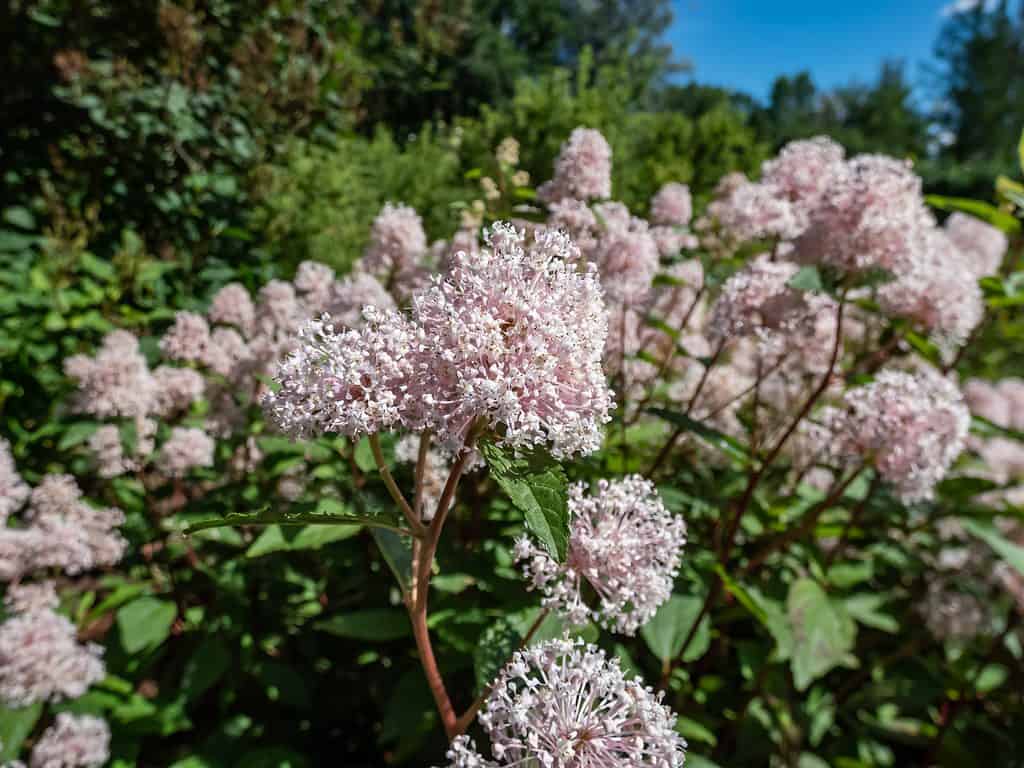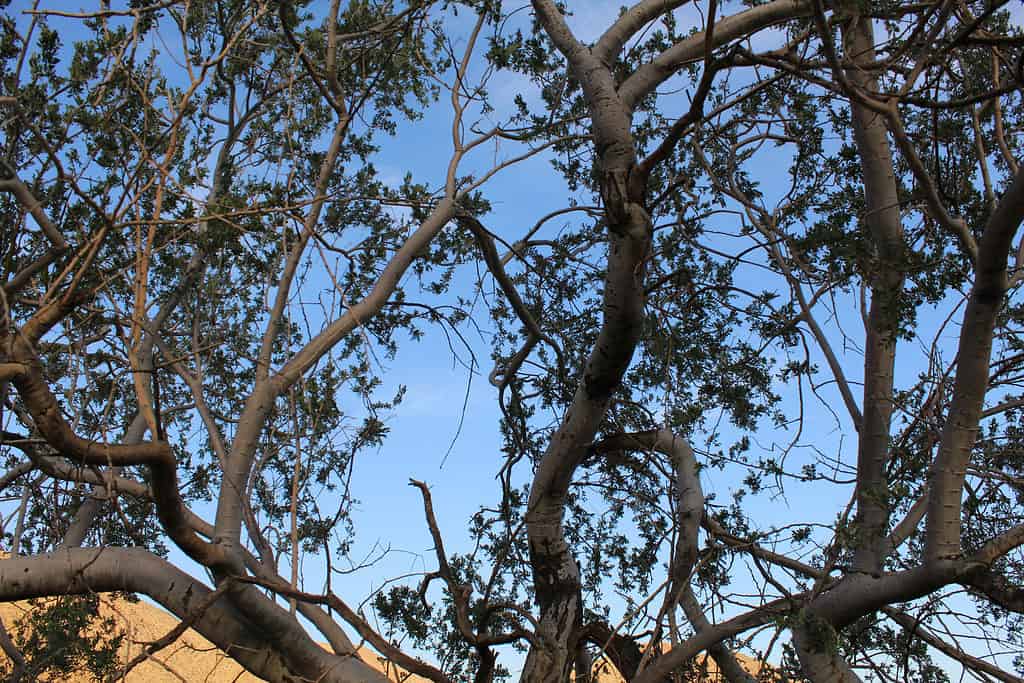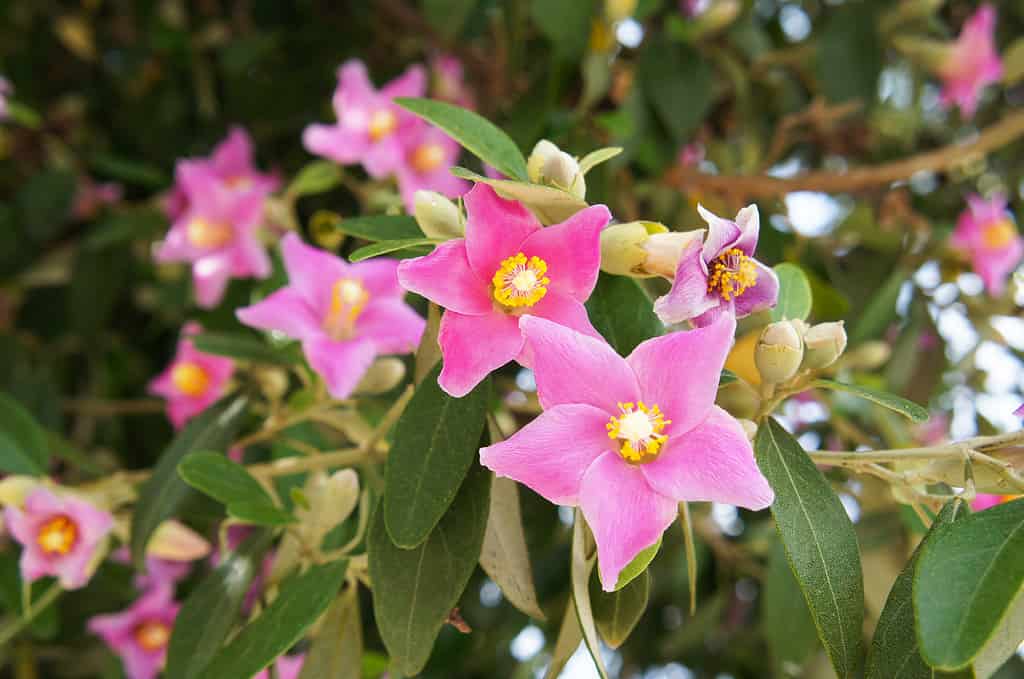Amidst the sun-kissed landscapes of California, a vibrant tapestry of flowering trees paints the scenery in hues of nature’s most splendid palette. These trees, adorned with blossoms that burst forth like confetti, stand as living testaments to the state’s diverse and captivating ecosystem. From the majestic coastline to the rolling hills, California’s flowering trees have stories to tell.
In this article, we’ll embark on a journey through the enchanting world of California’s blossoming arboreal wonders!
1. California Ash
The first entry on our list of flowering trees in California is none other than the California ash tree. California ash trees, scientifically known as Fraxinus velutina, are native deciduous trees that grace the landscape of the western United States. These trees exhibit a distinctive appearance, with a height ranging from 30 to 50 feet and a spread of up to 40 feet. Their oval-shaped leaves are medium green, characterized by a smooth texture and serrated edges. In the autumn, they transform into vibrant yellow or gold, adding a splash of color to the scenery.
These ash trees thrive in a variety of conditions, primarily favoring full sun exposure. They suit a range of soil types, including clay, loam, and sand. Adequate moisture during the growing season is crucial for their development, though they also possess a commendable drought tolerance once established. Because of their adaptability, they commonly inhabit a diverse array of habitats, from valleys to mountainous slopes.
California ash trees serve as valuable resources for local ecosystems, providing habitat and food for various birds and insects. However, they may face threats such as the emerald ash borer, an invasive insect that can cause significant damage. Regular monitoring and management are vital to safeguarding these trees.
In urban and suburban settings, California ash trees can be utilized as ornamental shade trees, enhancing the aesthetics of parks, streets, and gardens. Their distinctive appearance, adaptability, and contributions to the ecosystem make them a notable presence in the diverse plant life of the region.
2. California Lilac
We can’t have a list of flowering trees in California without including the California lilac tree! California lilac trees, which are part of the Ceanothus genus, are native shrubs or small trees that bring a touch of elegance to the landscapes of the western United States. These plants display a charming appearance, typically reaching heights of three to 10 feet. They are characterized by their glossy, deep green leaves and clusters of small, delicate flowers. The blossoms come in shades ranging from vibrant blue and purple to white, creating a striking contrast against the foliage.
Growing California lilac trees requires careful attention to their specific needs. These plants thrive in well-draining soil and prefer locations with full sun exposure, which promotes their optimal growth and flowering. Adequate air circulation is also important to prevent common issues like powdery mildew.
In terms of maintenance, California lilac trees appreciate occasional pruning to shape their growth and remove dead or diseased branches. Regular watering during the establishment period is essential, after which these trees exhibit notable drought resistance.
Beyond their aesthetic appeal, California lilac trees contribute to local ecosystems by providing nectar for pollinators like bees and butterflies. They can be incorporated into gardens, borders, or as focal points in a landscape design, adding both color and texture.

The
Ceanothusgenus of trees includes many vibrant flowering tree species and varieties.
©Kristine Rad/Shutterstock.com
3. Catalina Cherry
Catalina cherry trees, scientifically known as Prunus ilicifolia ssp. lyonii, are native to the coastal regions of California and Baja California. These trees present an attractive appearance, typically growing to heights of 15 to 30 feet. They possess a dense and rounded canopy comprised of glossy, dark green leaves that are reminiscent of holly leaves, lending the tree a unique and textured look.
The Catalina cherry tree’s growing requirements make it well-suited for its native coastal habitat. These trees thrive in areas with full sun to light shade, displaying their best growth and foliage coloration under such conditions. They are relatively adaptable to different soil types, although well-draining soil is essential to prevent root rot.
Regular irrigation is vital during the tree’s establishment phase, aiding its root development. Once established, Catalina cherry trees exhibit good drought tolerance, making them suitable for water-wise landscaping. Occasional pruning can help maintain a neat shape and encourage new growth.
One of the tree’s standout features is its production of small, white flowers in spring, which gives way to small cherry-like fruits that turn from green to dark purple as they ripen. These fruits are not only visually appealing but also attract various bird species that feed on them.
Catalina cherry trees hold ecological value by providing habitat and food for local wildlife. In residential landscapes, they can be utilized as ornamental trees or used for creating natural screens or windbreaks. Their adaptable nature, distinct appearance, and contributions to local ecosystems make them a valuable addition to the plant palette of coastal regions.
4. Desert Ironwood
Desert ironwood trees, scientifically termed Olneya tesota, are native to the arid landscapes of the Southwestern United States and northern Mexico. These trees boast a distinct and hardy appearance, typically reaching heights of 20 to 30 feet. Their crowns are comprised of small, dark green leaflets that create feathery and intricate foliage.
The growing requirements of desert ironwood trees are well-suited to their harsh native environment. They thrive in full sun exposure and require well-draining soil to prevent waterlogged roots. These trees have evolved to withstand arid conditions, showcasing remarkable drought tolerance once established. Additionally, they are capable of surviving temperature extremes, further reflecting their resilience.
Regular irrigation during the establishment period aids in root development, after which these trees can largely fend for themselves in low-water conditions. Minimal pruning is necessary, primarily for shaping purposes or to remove dead or damaged branches.
Desert ironwood trees are renowned for their dense and hardwood, which was historically used by indigenous peoples for various tools and carvings. Their small, purple pea-like flowers bloom in the spring, attracting pollinators like bees and butterflies. These flowers give way to long, twisted seed pods that house the tree’s seeds.
These trees play a crucial role in their native ecosystems, providing shelter and food for local wildlife. In landscaping, desert ironwood trees can be utilized to add a touch of rugged beauty to arid gardens or xeriscapes. Their unique appearance, adaptability, and ecological significance make them a distinctive feature of desert environments.

When fully grown, the Desert Ironwood can stand up to 30 feet tall and can be quite majestic.
©Jared Quentin/Shutterstock.com
5. Desert Peach
Desert peach trees, scientifically referred to as Prunus andersonii, are native to the arid regions of the Southwestern United States. These trees present a striking appearance, typically growing between 10 to 20 feet in height. They are known for their unique combination of silvery-gray leaves and delicate pink-to-lavender flowers that bloom in early spring, adding a touch of color to the desert landscape.
The growing requirements of desert peach trees reflect their adaptation to harsh environments. They thrive in full sun exposure and well-draining soil, often found in rocky or sandy areas. These trees exhibit exceptional drought tolerance once established, showcasing their ability to thrive with minimal water.
During the establishment period, regular irrigation is beneficial for root development. Afterward, these trees can withstand prolonged periods of drought, making them a valuable choice for water-wise landscaping. Pruning is primarily carried out for shaping purposes or to remove dead or crowded branches.
Following the flowering stage, desert peach trees produce small, fleshy fruits that range in color from yellow to orange-red. These fruits provide a source of food for wildlife and contribute to the local ecosystem.
In desert gardens or xeriscapes, desert peach trees can be utilized to create focal points or add visual interest with their distinctive foliage and early spring blossoms. Their adaptability to arid conditions, along with their contribution to local ecology, makes them a valuable addition to desert environments.
6. Honey Mesquite
Honey mesquite trees are another great member of flowering trees in California worth mentioning. Scientifically known as Prosopis glandulosa, these trees are native to the arid regions of North and South America. These trees exhibit a distinctive appearance, typically growing between 15 to 30 feet in height. They have a spreading canopy with feathery, fern-like leaves that offer a light and airy texture to the landscape.
The growing requirements of honey mesquite trees reflect their adaptation to arid climates. They thrive in full sun exposure and can tolerate a variety of soil types, including sandy and rocky soils. These trees are known for their exceptional drought tolerance, showcasing their ability to endure long periods of limited water.
During the establishment phase, regular irrigation helps with root development, but once established, honey mesquite trees require minimal water. Their deep-reaching roots enable them to access water stored deep within the soil.
Honey mesquite trees are valued for their versatility. They bear small, fragrant, creamy-white flowers in spring, which develop into flat, twisted seed pods. These pods provide a source of food for various wildlife, including birds and mammals.
In landscaping, honey mesquite trees can be used for shade and windbreaks, particularly in arid and semi-arid regions. Their adaptability, drought tolerance, and wildlife-supporting features make them an asset in water-conscious gardening and ecological restoration efforts. Despite their thorny nature, these trees are an essential part of arid ecosystems, offering both practical and ecological benefits.

Honey mesquite trees are known for their yellow-green foliage that has a similar appearance to a willow.
©Vipul1989/Shutterstock.com
7. Pineapple Guava
Pineapple guava trees, scientifically named Feijoa sellowiana, are charming additions to landscapes and are cherished for both their appearance and fruit. These evergreen trees typically stand around 10 to 15 feet tall, with their branches adorned by thick, leathery leaves showcasing a grayish-green hue on top and a silvery underside. Their distinct foliage adds an exotic touch to gardens.
Growing pineapple guava trees is relatively straightforward. They thrive in well-draining soil and prefer full sun to partial shade conditions. These trees tolerate a range of soil types but flourish when provided with regular water during their early stages. Once established, they demonstrate moderate drought tolerance.
What truly sets pineapple guava trees apart is their striking flowers. In spring, they produce stunning, fuchsia-colored blooms with crimson stamens that contrast brilliantly against the foliage. These flowers are not only visually pleasing but also attract pollinators like bees, leading to the formation of unique egg-shaped fruits.
The pineapple guava’s fruit is a highlight of the tree. With a green, textured skin and soft, aromatic flesh, the fruit carries a flavor reminiscent of pineapple and mint. These fruits are often enjoyed fresh or used in various culinary creations like jams, jellies, and desserts.
Pineapple guava trees make versatile additions to gardens, serving as ornamental plants with decorative foliage and as fruitful trees with delectable rewards. Their adaptability, combined with their aesthetic and culinary value, makes them a popular choice for gardeners seeking a touch of the exotic and flavorful in their outdoor spaces.
8. Primrose Tree
The last entry on our list of flowering trees in California is the stunning primrose tree. Primrose trees, scientifically referred to as Lagunaria patersonia, are enchanting flowering trees that lend a touch of elegance to various landscapes. These trees typically reach heights of 20 to 30 feet, boasting a graceful form and a rounded canopy. Their smooth, gray bark adds to their visual appeal, especially in winter months.
Growing primrose trees involves considering their specific needs. They thrive in areas with abundant sunlight, requiring at least six hours of direct sunlight daily to achieve their best growth and flowering potential. Well-draining soil is crucial for their health, preventing issues like root rot.
Regular irrigation during their establishment phase is vital to encourage strong root development. Once established, these trees display good drought tolerance, making them suitable for regions with periodic water restrictions. Pruning is often carried out in late winter or early spring to shape the canopy and promote air circulation.
One of the most captivating features of primrose trees is their vibrant and abundant flowers. They bloom in late spring or early summer, presenting clusters of showy blossoms in hues ranging from pink and lavender to white. These flowers not only add splashes of color but also attract pollinators like butterflies and bees.
Primrose trees can be used to enhance a variety of outdoor spaces, from residential gardens to parks and streetscapes. Their graceful form, colorful flowers, and adaptability to various climates make them a sought-after choice for those seeking to infuse their surroundings with natural beauty.

Primrose trees are known for their unique, tropical-looking blooms that add a touch of color to landscapes.
©skymoon13/iStock via Getty Images
Summary of the Best Flowering Trees that Grow in California + Even More Trees!
| # | Flowering Trees | Sunlight Requirements |
|---|---|---|
| 1 | California Ash | Full sun to partial shade |
| 2 | California Lilac | Full sun to partial shade |
| 3 | Catalina Cherry | Full sun to partial shade |
| 4 | Desert Ironwood | Full sun |
| 5 | Desert Peach | Full sun |
| 6 | Honey Mesquite | Full sun |
| 7 | Pineapple Guava | Full sun to partial shade |
| 8 | Primrose Tree | Full sun |
| 9 | Victorian Box | Full sun to partial shade |
| 10 | Western Redbud | Full sun to partial shade |
| 11 | Sweet Acacia | Full sun |
| 12 | Chokecherry | Full sun to partial shade |
| 13 | Desert Range Almond | Full sun |
| 14 | Australian Tea Tree | Full sun |
| 15 | Sweet Shade | Full sun to partial shade |
| 16 | California Flannelbush | Full sun to partial shade |
| 17 | Chitalpa | Full sun |
| 18 | Screwbean Mesquite | Full sun |
| 19 | Blue Elderberry | Full sun to partial shade |
| 20 | Fremont Cottonwood | Full sun to partial shade |
| 21 | Smoke Tree | Full sun |
| 22 | Godding’s Black Willow | Full sun to partial shade |
| 23 | Creek Dogwood | Full sun to partial shade |
| 24 | Paperbark Tea Tree | Full sun |
| 25 | Oregon Crab Apple | Full sun to partial shade |
| 26 | Marina Strawberry Tree | Full sun to partial shade |
| 27 | Water Gum | Full sun to partial shade |
| 28 | Tobacco Brush | Full sun |
| 29 | Mountain Alder | Full sun to partial shade |
| 30 | New Zealand Christmas Tree | Full sun |
The photo featured at the top of this post is © Erika J Mitchell/Shutterstock.com
Thank you for reading! Have some feedback for us? Contact the AZ Animals editorial team.







